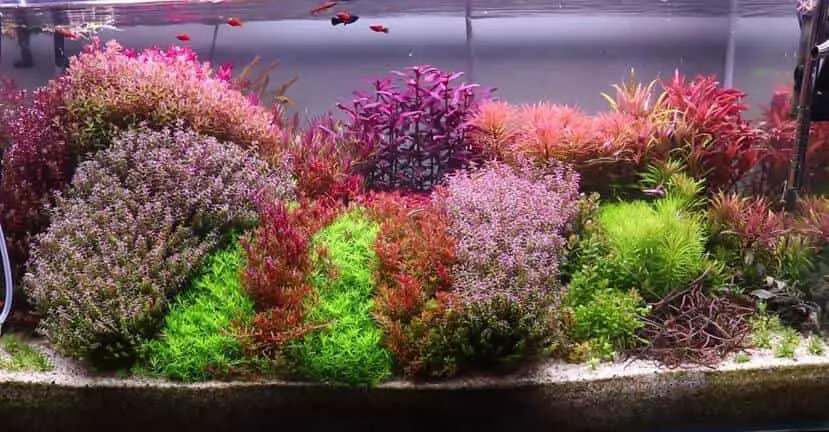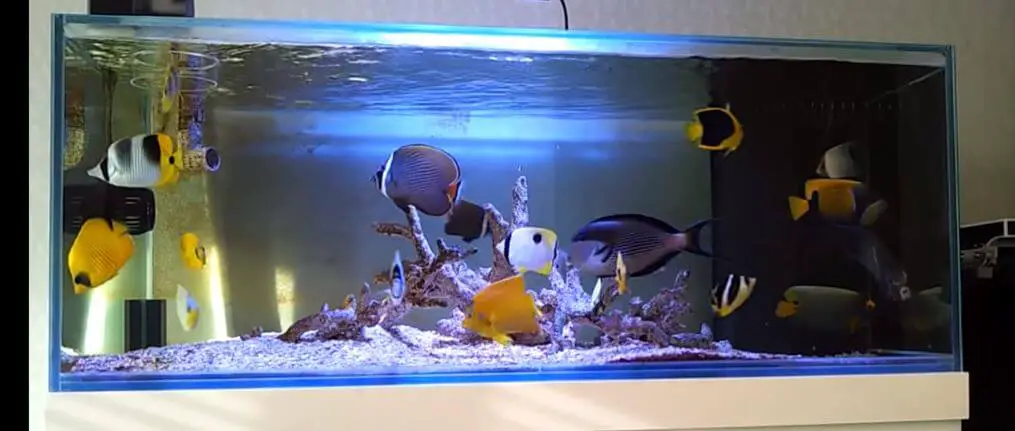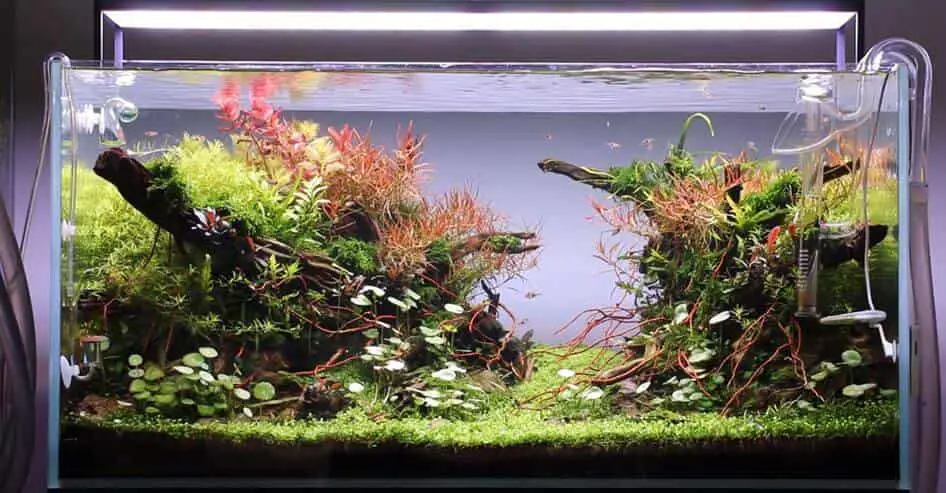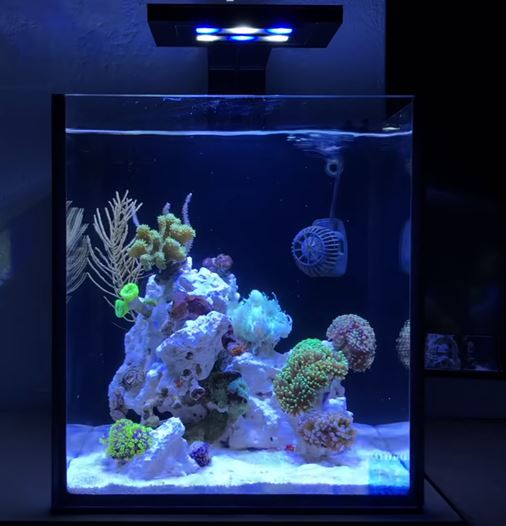Aquarium lighting is one of the top factors that determine the success for your fish tanks. However, if you are new to fish keeping, selecting the perfect light for your aquarium is not easy.

To help you understand aquarium lighting systems, I will discuss the importance of aquarium lights, the types of lights currently on the market and how to choose the right light for your aquarium.
Let’s get started!
Contents
The Role of Light in Fresh Water Aquarium Tanks
If you are new into the aquarium hobby, then choosing the perfect light for your tank can be overwhelming. Before we dig into the details of different types of aquarium lighting, you must learn about the different functions of aquarium lighting. Aquarium lighting fulfills several purposes.
For Plants:
Plants rely heavily on light as it allows them to live and remain healthy. However, the amount of light needed by every plant differs.

Three kinds of plants usually require high light levels:
- Tropical plants need maximum light for photosynthesis.
- Plants that grow close to the surface of the water need lots of light to mimic the sun.
- Plants with red in the stems or leaves usually require high levels of light to remain healthy and live longer.
Other than that, all the other plant species demand a moderate level of light. Thus, before choosing the perfect light it’s helpful to know the type of plants you could grow.
For Fish:
Fish also need light. Fish health and vision is highly dependent on the light quality. Some fish can see polarized light and ultraviolet light.
A lot of hobbyists often worry about adding vibrant light to their aquarium as it might cause an excessive algae outbreak. A good system setup will include ways to reduce or eliminate algae and still use lights.
Most Popular Types of Aquarium Lights
There are three common types of lights for aquariums. We won’t mention room lighting or sunlight. Both can be effective with the right tank. For now, we’ll stick to more direct light installed for each tank.
1-Fluorescent Tubes (T5 & T8 Type)

Fluorescent Tubes have a much greater life span than the regular incandescent light bulbs. They are also environmentally friendly and have a lower maintenance cost.
These lights have two basic types: normal output fluorescent tubes and compact fluorescent lighting. The second type are energy-efficient lights designed to replace the regular bulbs.
Pros
Fluorescent tubes are energy efficient and cost-efficient as compared to other traditional bulbs. They last longer and require no maintenance. You can choose the desired color temperature with warm whites to cool whites. Light diffusers reduce harsh shadows.
Cons
These lights have a magnetic ballast that can be noisy while running. Sometimes they flicker at a high frequency. This can be irritating people with eye strains, migraines, and headaches.
2-LED Lights

LED lights are more modern than standard fluorescent and metal halides lights. They come in many customizing lighting colors and intensities.
Pros
LED lights offer less heat production compared to other light bulbs, so you won’t have to worry about heating your aquarium water.
They also offer an adjustable light intensity that can be dimmed and increased with automatic settings. Different shapes are available. The most common lights are arrayed in a strip.
If you have a huge tank, then LED lights are the perfect option for you to add affordable lighting.
Cons
LED lights tend to be more costly than other lights to purchase but cheaper to run. Your basic budget will need to be a little higher.
In addition, LED lights may not provide enough lighting strength for planted aquariums. A lot of LED lights are only useful for medium lighting needs.
3-Metal Halide Lamp

Metal Halide lamps supply light through their ballast. It has a higher voltage than other tube lights, such as fluorescent lighting.
Pros
Metal halide lamps usually have an average lifespan of 15,000-20,000 hours. The output of metal halides is much closer to natural sunlight than most other lights. It has an excellent color rendering and different colors can be chosen.
Cons
Metal halide lamps at times produce too much heat because of their high voltage. This can increase the water temperature too much.
They can be difficult to start as you must use a special trigger to start it.
The Basic Parameters of Aquatic Lights
Lighting is not too complicated to understand. There are about five major points about lights to keep in mind. We’ll go through them one by one.
1-Wattage
Watts are a common way of measuring light output(for T5HO light and metal halide lamp). There are a couple of simple rules of thumb for how many watts of light to use:
- 1-2 watts per gallon for fish-only aquariums and 2-5 watts per gallon for planted freshwater tanks.
- Marine tanks should use 4-8 watts per gallon.
Your tank needs could be different based on your choice of plants and the shape of your tank. A very shallow tank needs less light. Deeper tanks need more light because the light must shine all the way to the bottom.
2-Lumen
Lumens are another way of measuring the output of LED lights. People usually link lumens to plant needs.
- If your plants are easy and need low light levels, then 10-20 lumen per liter of water is perfect.
- For medium plants, 20-40 lumens per liter is usually recommended.
- 40 lumens per liter is recommended for advanced plants with high lighting needs.
Photosynthetic Active Radiation- PAR
PAR is the amount of light in a certain range of colors that penetrates water and plants use for growth. For beginner hobbyists, PAR is probably not the most important number to consider. Tuning reef tanks to grow more coral is possible using PAR as a measurement. For freshwater tanks and simple setups, PAR is not as important as simply getting enough light into the tank.
Kelvin Rating
Plenty of aquariums have a light kelvin rating of 5,000K-20,000K. Kelvins are a measurement of the color spectrum of lighting. Plants grow best with light between 300-700 nanometers in wavelength. That translates to around 6400 Kelvin. Try to choose lights that provide this color and you should be fine.
Light Spectrum
The light spectrum, as you can see, is measured in different ways. Watts, lumens, kelvins, and PAR are all different ways of describing light color and intensity. Here are two guides to help you sort through all the numbers:
- Choose your lighting based on your tank size and our watt rules of thumb. This will give your lights enough power to support your tank.
- Choose your lighting to match the Kelvin temperature for the best color. 6400 Kelvin lights are a good choice for most beginners.
How to Choose the Right Type of Light for Your Freshwater Aquarium?
Now you can see the wide variety of lights and choices available. This can all become overwhelming. Let’s work through this step by step so you can make a good choice.
Fish and Plant Needs
Most people add lights into their aquarium to fully enjoy the beauty and uniqueness of plants and fish. It’s essential for fish to have lights so they can see, have a look around, get food for themselves, and not get confused. Other than the human enjoyment, fish and plants have their own lighting needs. Aquatic plants grow in open water. Light is usually brighter there and they require it to live longer and grow taller.
Light is crucial for both fish and plants as their necessity for life. To grow properly, a lot of aquarium plants require 8 to 10 hours of daily sunlight. To cover that, you might need a good-quality and high-intensity light for your fish tank.
Light Intensity and Spectrum
Every light differs according to its voltage and other intensity. Intensity means the brightness that a light provides and spectrum refers to the mixture of multiple colors. Light spectrum comes with a Kelvin rating, the warm effects are usually given a low rating whereas cool light waves are given a high rating. The basic K-rating for most aquariums varies between 5,500 and 8,000.
Our Recommendation for Lighting System
Now let’s give you some specific recommendations for which lights to choose.
1-Fish-only Aquariums

Fish-only aquariums refer to artificial plants, ceramics, decorative wood, and fish. Our best recommendation is to add a standard fluorescent or LED system.
For a fish-only aquarium, a lighting system of 1 to 2 watts per litre (or 10-20 lumens if it is LED light) is sufficient to ensure a proper day-night cycle.
You can choose the spectrum and intensity according to your preference because there are no living plants to support.
The only thing to monitor is algae growth. If your lighting is too intense, algae will form rapidly. Simply leaving the lights off for a few days and cleaning the algae should reduce this problem.
2-Freshwater planted Aquariums

Freshwater planted aquariums include live plants, decorative wood, and fish. The standard recommendation is to add T5 HO, VHO, Metal Halide/HQI, Power Compact lights or some special LED lights.
We make this recommendation because most of the freshwater plants come from open streams and rivers of South America and Central America. They have access to high-intensity sunlight for 8 to 10 hours as a minimum.
Now depending on the tank’s depth and length, you must have a fluorescent system between 2 to 5 watts per gallon (20-40 lumens for LED light).
Only choose plants that will work with your lighting system. If your lights are a bit too bright, you can raise the fixture slightly above the cover to reduce their intensity.
3-Saltwater Reef Aquariums

This type of aquarium involves invertebrates, corals and fish. The recommended lighting system is LED lights, VHO, Power Compact and HQI/Metal Halide.
Corals and invertebrates are living organisms and require light. However, every coral requires different intensities of light. A lot of corals come from a sea depth of 16-70 feet where light is intense, while some survive even on low-light circumstances. Check with your coral provider for more information.
To light up a reef aquarium of 24”, you must have a lighting system of 4 to 8 watts per gallon. You can relax a little if you are keeping invertebrates and corals that require moderate lighting.
Frequently Asked Questions
Q1-How many hours a day should my fish tank light be on?
Most of the plants and fish require 8 to 12 hours of lighting each day to survive and grow properly. Thus in general, 10 hours is the best ratio for light each day. A timer switch can automate this and help keep everything healthy. Also, if you have algae problems, a timer switch can break up your lighting time into several periods, such as four hours on followed by four hours off. This can disrupt the algae growth cycle.
Q2-Can I leave my aquarium light on 24/7?
It is not much likely or beneficial to leave your aquarium light on for 24 hours, it should only be left on for 10-12 hours and not more than that. Too much light can lead to the promotion of algae and encourage stress levels in fish.
Q3-Can fish sleep with the light on?
Yes, but many fish do not sleep in the day. Bettas, for example, are diurnal and sleep at night. A good light cycle helps these fish stay healthier.
Q4-What Color light do fish like?
Fish usually prefer warm colors such as shades of blue, so a bright light spectrum of 10,000k light will showcase a warm yet shiny effect on your fish. Blue lights usually mimic moonlight and encourage better physical activity.

